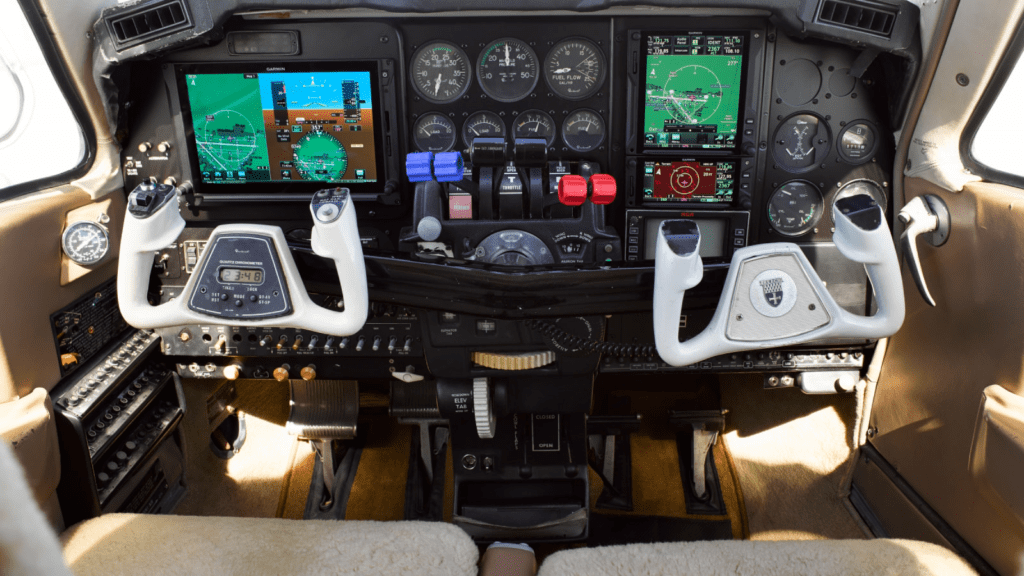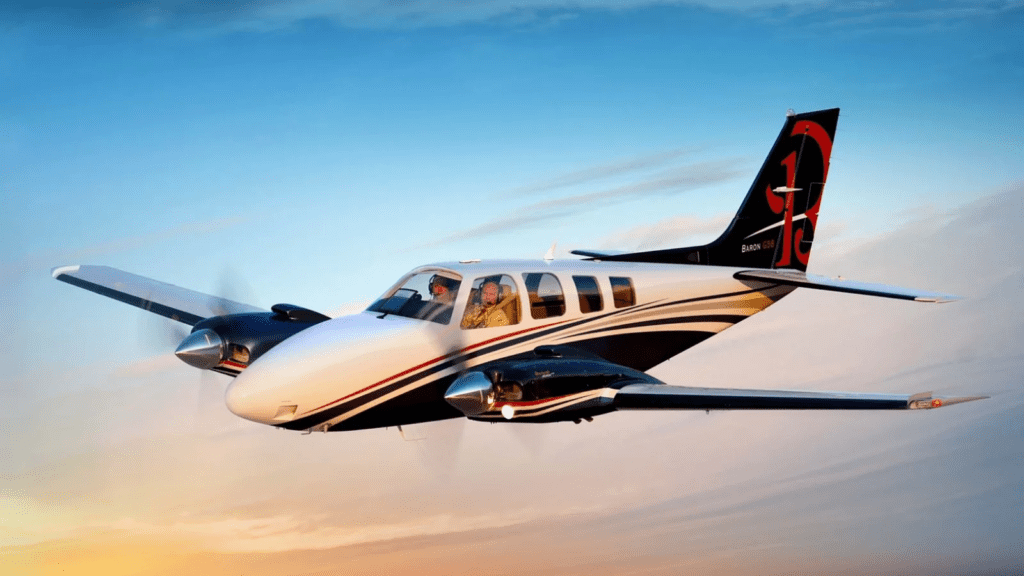The Complete Guide to the Beechcraft Baron 58: Specs, History, Safety, and Flying Tips.

The Beechcraft Baron 58 is a pinnacle of twin-engine general aviation, celebrated for its speed, range, and luxury. Often referred to as the “sports car of the skies,” the Baron 58 has earned its reputation as a versatile aircraft for business, leisure, and training. This blog will provide an in-depth look at its performance specifications, history, safety record, critical speeds, flying characteristics, and any prohibited maneuvers.
A Brief History of the Beechcraft Baron 58
The Beechcraft Baron lineage began in the 1960s as a derivative of the Beechcraft Bonanza. First introduced in 1969, the Baron 58 was an evolution of earlier Baron models, featuring larger engines, a stretched fuselage, and improved performance. This aircraft was designed to provide exceptional power and comfort, making it ideal for business professionals and aviation enthusiasts.
The Baron 58 remains in production today, with modern variants boasting advanced avionics, turbocharged options, and pressurization. Known for its solid build and twin-engine reliability, the aircraft has become a go-to choice for pilots who demand performance and versatility.
Performance Specifications
The Baron 58 offers impressive performance that caters to both private and commercial pilots. Here are the key specifications for the standard non-turbocharged Baron 58:

- Engines: 2 x Continental IO-550-C (300 horsepower each)
- Fuel Capacity: 194 gallons (192 usable)
- Cruise Speed: ~200 knots (370 km/h)
- Maximum Speed: 202 knots (374 km/h)
- Range: ~1,000 nautical miles with reserves
- Service Ceiling: 20,688 feet (6,306 meters)
- Rate of Climb: ~1,700 feet per minute
- Takeoff Distance: ~2,345 feet (ground roll)
- Landing Distance: ~1,490 feet (ground roll)
For pilots seeking even more capability, the turbocharged Baron 58TC and pressurized Baron 58P offer enhanced high-altitude performance.
- Latest CPU’s Available Now – Amazon.com
- Get a NEW GPU Best Performance – AMAZON.com
- Upgrade RAM Here today – AMAZON.com
- Prebuilt PC Options – AMAZON.com
Critical Y Speeds
Operating a twin-engine aircraft like the Baron 58 requires familiarity with a different set of critical speeds compared to single-engine planes. Here are the key V-speeds for the Baron 58:

- Vso (Stall Speed, Landing Configuration): 73 knots
- Vs1 (Stall Speed, Clean Configuration): 84 knots
- Vr (Rotation Speed): 85 knots
- Vx (Best Angle of Climb): 92 knots (all engines operating)
- Vy (Best Rate of Climb): 105 knots
- Vmc (Minimum Control Speed, Single Engine): 84 knots
- Vle (Maximum Landing Gear Extended Speed): 152 knots
- Vfe (Maximum Flap Extended Speed): 122 knots
- Va (Maneuvering Speed): ~152 knots (depending on weight)
- Vno (Maximum Structural Cruising Speed): 195 knots
- Vne (Never Exceed Speed): 223 knots
Knowledge of these speeds is critical for safely managing normal operations and emergencies, particularly in single-engine scenarios.
Single-Engine Performance, Adverse Yaw, and the Critical “No Spin” Warning

The Baron 58’s single-engine performance is a testament to its robust design, allowing it to maintain level flight and even climb under certain conditions when one engine is lost. However, single-engine operation introduces significant challenges, including asymmetric thrust, which demands immediate corrective action from the pilot.
Maintaining directional control is critical, as failure to counteract the yaw caused by the operating engine with rudder input can lead to adverse yaw, resulting in a dangerous loss of control. This risk underscores the importance of keeping the aircraft above Vmc (minimum control speed) to prevent an uncontrollable yaw and roll.
Additionally, the Baron 58’s “No Spin” certification must be strictly adhered to, as twin-engine aircraft like this one are not designed for spin recovery. The large mass of the engines on the wings exacerbates inertia forces during a spin, making recovery nearly impossible.
Pilots must avoid the conditions leading to a spin at all costs, especially during slow-speed maneuvers or engine-out scenarios. These characteristics highlight the Baron 58’s need for disciplined piloting and the importance of adhering to its operational limitations to ensure safe flight.
Safety Record

The Baron 58 has an excellent safety record, particularly when flown by experienced pilots who understand the nuances of twin-engine operation. Its robust airframe and redundancy from having two engines provide significant safety advantages. However, certain risks are inherent:
- Engine-Out Procedures: In the event of an engine failure, the pilot must promptly manage the aircraft’s asymmetric thrust and maintain minimum control speed (Vmc).
- Fuel Management: With a large fuel capacity and high fuel burn rate, pilots must carefully monitor fuel levels and ensure proper tank selection.
- High-Performance Demands: The Baron 58’s power and speed can overwhelm less experienced pilots, especially during takeoff and landing.
Overall, the aircraft’s systems and design are reliable, but proper training and adherence to procedures are paramount for safe operation.

Flying Attributes
Pilots appreciate the Baron 58 for its responsive handling and impressive performance. Below are some of its standout attributes:
- Powerful Climb Performance: With 300 horsepower per engine, the Baron 58 offers strong climb rates, even in hot and high conditions.
- Smooth Handling: Its well-balanced controls and predictable flight characteristics make it enjoyable for experienced pilots.
- Comfort and Space: The Baron 58’s spacious cabin and club seating arrangement provide unparalleled comfort for passengers on long flights.
- Single-Engine Reliability: Although losing an engine is always a challenge, the Baron 58 performs better than many twins in single-engine flight, thanks to its well-designed aerodynamics.
Known Dangers and Prohibited Maneuvers
While the Baron 58 is a high-performing aircraft, there are specific dangers and limitations that pilots must respect:
- Engine-Out Risks: Failure to maintain proper speed and coordination during engine-out operations can result in loss of control. Maintaining above Vmc (minimum control speed) is essential.
- High-Speed Risks: Exceeding Vne (223 knots) can cause structural damage, particularly in turbulent conditions.
- Prohibited Aerobatics: The Baron 58 is not certified for aerobatic maneuvers, such as spins, loops, or rolls. Attempting these could lead to catastrophic outcomes.
- Crosswind Landings: With a maximum demonstrated crosswind capability of ~22 knots, pilots must exercise caution during gusty conditions.
- Density Altitude: At high altitudes and temperatures, performance is significantly reduced, affecting takeoff and climb capabilities.

Beechcraft Baron 58 Pilot Operating Manual

To operate the Baron 58 safely and efficiently, pilots must familiarize themselves with its Pilot Operating Handbook (POH). The manual provides detailed guidance on: (Direct Download From LetsFlyVFR.com).
- Normal and emergency procedures
- Performance charts
- Weight and balance calculations
- Systems descriptions
You can find more information and sample materials for the Beechcraft Baron 58 here.
- Joystick / HOTAS – AMAZON.com
- Rudder Pedals – AMAZON.com
- Throttle Quadrant – AMAZON.com
- Gaming Chair – AMAZON.com
- VR Headset – AMAZON.com
Conclusion
The Beechcraft Baron 58 stands out as a premium choice for pilots seeking power, speed, and luxury in a twin-engine platform. Its reliability and advanced performance make it suitable for both business and personal use, while its robust systems and design enhance safety when properly flown.
By understanding its specifications, critical speeds, and limitations, pilots can fully harness the potential of this incredible aircraft. Whether for short hops or cross-country flights, the Baron 58 continues to define excellence in general aviation.

Author
Brendon McAliece (Aka Gunnie) is a military veteran with 23 years working on Jet Fighters, their weapons systems and ejection seat/module systems as well as munitions and R&D. Involved with flight simulation since the 1980s, he has flown all the major flight simulators over the years.
He is an Australian expat who has lived in Malaysia, UK, Saudi Arabia and more recently Thailand. He is a multi-lingual blogger who loves to share his life experiences here on LetsFlyVFR.com and DreamingGuitar.com, with his lifestyle and Travel experiences Blog plus his Dreaming Coffee website.
Learn More @
DreamingGuitar.com – DreamingCoffee.com – LetsFlyVFR.com
( HOME – BLOG – SHOP – ABOUT )
As an Amazon affiliate I may benefit from qualifying sales.
